
Rhinopharyngitis is a disease characterized by inflammation of the nasal mucosa and pharynx. Most often this is a complication after an acute form of rhinitis. The child experiences pain during swallowing. Treatment of rhinopharyngitis should be started as soon as possible, otherwise it can go into a chronic form.
Contents
- 1 Types and Symptoms
- 1.1 Acute
- 1.2 Allergic
- 1.3 Chronic
- 2 Treatment of medical
- 3 Unconventional means
- 4 Opinion of Komarovsky
Types and symptoms of
The symptoms of the disease are determined by taking into account what form it was diagnosed.
Acute
Recognize the acute form of the pathological process in children, for such symptoms as nasal congestion, sneezing. Since there is an accumulation of secretions in the nasal cavity, the baby has difficulty in feeding. He is forced to constantly throw out his chest to get another portion of air through his mouth. Because of this baby can not eat and lose weight. To facilitate his breathing, you need to tilt his head slightly.
At first, the nose discharge diseases have a liquid consistency, they are transparent, but over time they become viscous and mucous. Sometimes from a nose there can be a pus. Due to the fact that the discharge from the nose irritates the skin, redness arises. It is extremely rare from the nasal cavity, along with mucus can be allocated blood veins. In the posterior sections of the nasal cavity, stagnation of mucus is observed, which arises from a complicated outflow. Thus, the nasal passages narrow even more, and the child is no longer able to breathe fully.
If we consider the acute course of rhinopharyngitis in older children, the characteristic signs of them are sore throat, headache and body aches. A frequent symptom of the pathology remains stuffy in the ears and hearing loss.
This indicates that the inflammatory process has struck the Eustachian tube. The voice becomes nasal. In the future, there may be pain in the ear. Lymph nodes, located on the neck and under the jaw, increase in size. 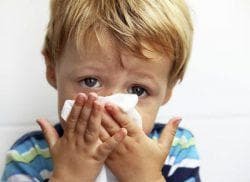
As for the temperature indicators, they can rise to high levels, although there are cases when the increase is insignificant. In young patients, a convulsive condition may arise due to a rise in body temperature.
In case of acute inflammation of the pharynx, in addition to the pain syndrome, a cough occurs. During the examination of the throat, the doctor diagnoses reddening of the mucosa and mucus that moves along the back wall of the pharynx, which can lead to vomiting in the child. There are situations when, instead of vomiting, the child has diarrhea and flatulence.
 How is tonsillitis treated during pregnancy, and by what means, is described in this article.
How is tonsillitis treated during pregnancy, and by what means, is described in this article.
And here's how to use an asterisk in pregnancy for a cold, described in this article.
How to use ginger for colds during pregnancy is described in detail in this article: http: //prolor.ru/g/lechenie/ imbir-pri-prostude-kak-ego-upotreblyat.html
Why does the ear become stuffy without pain after a cold and how can this problem be dealt with,will help to understand this article.
Allergic
This pathological process most often occurs in the summer, when grasses and trees bloom. Influence on its development can contact with other allergens. According to the clinical picture, it is not always possible to distinguish allergic rhinopharyngitis from other pathologies.
The main symptoms of the allergic form of rhinopharyngitis include:
- nasal congestion, which occurs due to pronounced puffiness of the mucosa;
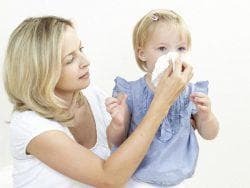
- abundant discharge of mucus from the nasal cavity;
- burning and itching in the nose;
- redness of the eyelids and active release of tears;
- a sore throat;
- the baby prefers to sleep on the back;
- cough.
The symptomatology of the pathological process is declining when contact with the allergen is over.
Chronic
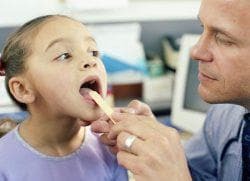
This pathological process is accompanied by a prolonged course and results from an incomplete acute process. The disease can be of three types: catarrhal, atrophic and hypertrophic. In the chronic form of pathology, perspiration in the throat persists, even if treatment has been performed.
In this case, the child is noted hoarseness of voice and pain in the throat. He is worried about a frequent unproductive cough, which can cause a vomiting reflex. The structure of the tonsils is loose, and their size is increased. Lymph nodes also swell.
Medical treatment
If a child has been diagnosed with acute rhinopharyngitis, then to facilitate the patient's condition, the doctor will include in his therapy scheme such medications:
- Vasodilating drops. The following drugs are the most effective today: Vibrocil( and that's better for children Vibrocil or Nazivin, will help to understand this information) Nazivin baby for newborns, Otrivin( and here's how to use children's drops in the nose of Otrivin, described in this article) Lazolvan Reno( but how to do inhalation with genyantritis Lazolvanom, will help to understand this article) But they need to be used for a short time, as only remove unpleasant symptoms, but do not eliminate the root of the problem.
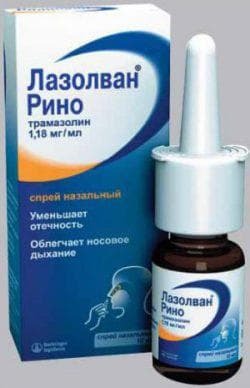
Lazolvan Reno
- Healing drops . Protargol is considered to be the ideal drug for treating a common cold.( But how to use Protargol with nasal congestion in children is described in detail in the article) This medicine is sold in a prescription pharmacy. Presented in the form of oil droplets, which contain plant substances. There are situations, the doctor's code can assign complex compound drops that have both antimicrobial and vasoconstrictive effects. Their composition is chosen, taking into account the age of the baby.

Protargol
- Antihistamines .They are prescribed as a symptomatic treatment to remove swelling in the nasal cavity, lacrimation and abundant mucus secretion. To such drugs should include Tavegil, Suprastin, Erius, Fenistil. They can be used to treat a child of 1 year.
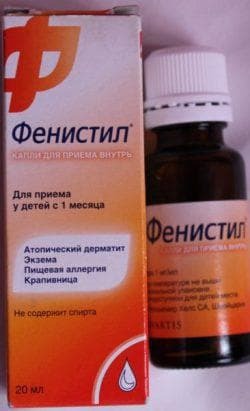
Fenistil
- Sprays and lozenges .Their doctor prescribes when the infection struck the throat. But they can only be used by children from 4 years of age. Such preparations as Tantum Verde, Geksoral, Ingalipt, Cameton remain popular.
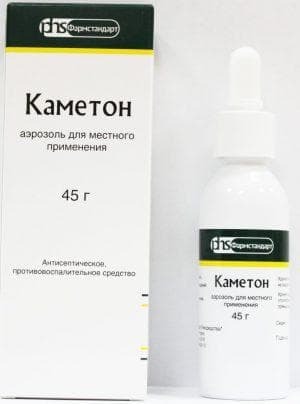
Camleton
- Very often, when treating a reflex attack of a cough, a child may be prescribed a medicine such as Paxeladin. But only before using it you need to get a doctor's approval. And this is due to the fact that bronchitis and inflammation of the lungs this drug can aggravate the situation.
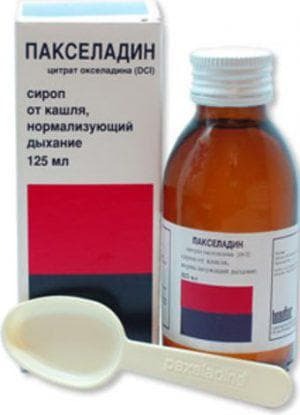
Paxeladin
- In rhinopharyngitis therapy, it is absolutely necessary to include a procedure for nasal irrigation in the treatment regimen. In this case, Humer, Atomer, and Aqua-Maris remain effective. With their use, it is possible to increase the immune defense of the nasal mucosa, reduce inflammation.
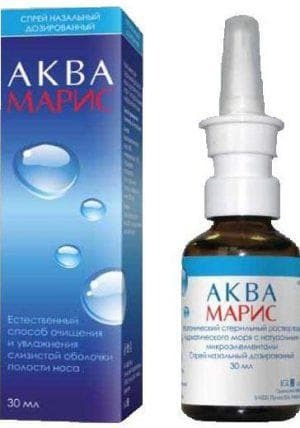
Aqua-Maris
Unconventional means of
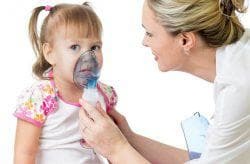
In the therapy of rhinopharyngitis, very often non-traditional medicine is used. But only use them in combination with the main therapy and after consulting a doctor. The following recipes remain effective in this case:
- Inhalation .To conduct this procedure, you must prepare a decoction of herbs such as chamomile, calendula. You can still inhale a couple of boiled potatoes. Inhalation with babies should be done carefully so that the mucous membrane does not burn. Juice of beet and Kalanchoe .They are used as drops for the nose or rinse solution. You can also use the composition of finely chopped garlic, filled with boiling water.
- Tea with lemon and honey .This tool has a general strengthening effect. But you can drink it only if the child is not allergic to citrus and bee products.
Komarovsky's opinion
Komarovsky is a famous pediatrician whose opinion is important for many parents. In the treatment of rhinopharyngitis, he advises to carry out such activities:
- . As often as possible, drink a child, while drinking should be warm.
- Fill the child's room with fresh air.
- To exclude the effect on the children's body of cold. Do not wipe with a cold towel, apply ice.
- It is forbidden to rub dry skin, as it is capable of instantly absorbing the remedies that are used in grinding - vodka, vinegar.
- It is compulsory to see a doctor so that he takes a smear from the pharynx and blood in order to understand what caused the pathological process.
On video-acute rhinopharyngitis in children treatment on the advice of Komarovsky:
Rhinopharyngitis is a disease in children, which is inflammatory. It can occur in the acute and chronic phase. For the acute characterized by a pronounced clinical picture, so that parents can react in time and take the child to the hospital. But, when the pathology has passed to the chronic stage, it is important how it is possible to prolong the remission for a longer time and to alleviate the child's condition during an exacerbation.
